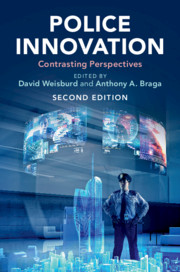Book contents
- Police Innovation
- Police Innovation
- Copyright page
- Contents
- Figures
- Tables
- Notes on Contributors
- Introduction
- Part I Community Policing
- Part II Procedural Justice Policing
- Part III Broken Windows Policing
- Part IV Problem–Oriented Policing
- Part V Pulling Levers (Focused Deterrence) Policing
- Part VI Third–Party Policing
- Part VII Hot Spots Policing
- Part VIII Predictive Policing
- Part IX CompStat
- Part X Evidence-Based/ Risk-Focused Policing
- 19 Advocate
- 20 Critic
- Part XI Technology Policing
- Index
- References
19 - Advocate
Evidence-Based Policing for Crime Prevention
from Part X - Evidence-Based/ Risk-Focused Policing
Published online by Cambridge University Press: 09 August 2019
- Police Innovation
- Police Innovation
- Copyright page
- Contents
- Figures
- Tables
- Notes on Contributors
- Introduction
- Part I Community Policing
- Part II Procedural Justice Policing
- Part III Broken Windows Policing
- Part IV Problem–Oriented Policing
- Part V Pulling Levers (Focused Deterrence) Policing
- Part VI Third–Party Policing
- Part VII Hot Spots Policing
- Part VIII Predictive Policing
- Part IX CompStat
- Part X Evidence-Based/ Risk-Focused Policing
- 19 Advocate
- 20 Critic
- Part XI Technology Policing
- Index
- References
Summary
In recent weeks Big City has experienced an increase in young people selling drugs on the street. The police chief directs one of his managers to organize a small group of officers to look into the matter and report back with a plan of action. One of these officers is tasked with researching what works to address the problem of street-level drug sales. The officer carries out literature searches, contacts other police departments and police research organizations such as the Police Foundation, and follows up with some of the researchers involved in evaluation studies. The most rigorous evaluations are coded according to the outcomes of interest, results are analyzed, and a report is prepared that shows what type of intervention works best. Detailed observational and other information on the problem gathered by the other officers is used to assess the applicability of the “best practice” to the local context and conditions. On the basis of this information, the chief authorizes the needed resources for a program to be implemented to address street-level drug sales, and introduces a monitoring and evaluation scheme to aid in-house policy and for dissemination purposes.
- Type
- Chapter
- Information
- Police InnovationContrasting Perspectives, pp. 439 - 456Publisher: Cambridge University PressPrint publication year: 2019
References
- 4
- Cited by



